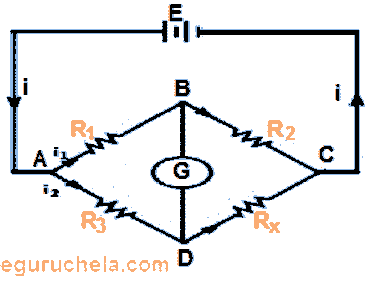Wheatstone Bridge
The Wheatstone Bridge was originally developed by Charles Wheatstone to measure unknown resistance values and measuring instruments, voltmeters, ammeters, etc.
Although today digital multimeters provide the simplest way to measure a resistance, The Wheatstone Bridge can still be used to measure very low values of resistances down in the milli-Ohms range.
A Wheatstone bridge is an electrical circuit used to measure an unknown electrical resistance by balancing two legs of abridge circuit, one leg of which includes the unknown component.
The primary benefit of a wheatstone bridge is its ability to provide extremely accurate measurements .

is the unknown resistance to be measured; R1,R2 and R3 are resistors of known resistance and the resistance of R2 is adjustable.
If the ratio of the two resistances in the known leg (R2/R1) is equal to the ratio of the two in the unknown leg (Rx/R3), then the voltage between the two midpoints (B and D) will be zero and nocurrent will flow through the galvanometer (VG).
If the bridge is unbalanced, the direction of the current indicates whether R2 is too high or too low.
R2 is varied until there is no current through the galvanometer, which then reads zero.
Formula
Where,
R = unknown resistance
S = standard arm of the bridge
P & Q = ratio of arm of bridge

Limitations
The Limitations of wheatstone bridge are as follows:
For high resistance measurement, the measurement represented by the bridge is so large that the galvanometer is insensitive to imbalance.
The other drawback is the change in resistance due to the heating effect of the current through the resistor.
Excessive current can also cause a permanent change in the value of the resistance.
For low resistance measurement, the resistance of the leads and contacts becomes critical and introduces an error.
Applications
The Applications of wheatstone bridge are as follows:
Wheatstone bridges are used for precise measurement of low resistance, it is used with an operational amplifier to measure physical parameters such as temperature, light and tension.
